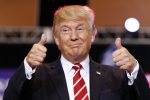In less than two weeks, President Trump will decide whether to withdraw from the Iran deal. The international nuclear agreement, completed under former President Obama, is only three years old. The negotiations were historically groundbreaking; nevertheless, President Trump has made no secret of his belief that the agreement is “terrible” and that the United States was “out-negotiated.”
According to the deal, the president must issue a certification to Congress every 90 days reaffirming his or her approval of the terms. The next deadline is May 12. President Trump has given European signatories until then to “fix” the deal; unless the conditions have been adjusted to the president’s satisfaction, the U.S. will not reaffirm its commitment.
Over the past few years, Trump has repeatedly insulted the Iran deal, calling it “a catastrophe,” “stupid,” “insane” and “horrendous.” All these disparaging terms would indicate towards the president cutting the U.S. out of the agreement, no matter what European allies do to “fix” a deal they’re actually quite happy with.
Negotiations with Iran have dotted America’s history. Time and time again, American leaders have attempted to make the Middle Eastern country suspend enrichment of uranium, the ore used in making nuclear weapons.
However, despite the United Nations’s demands and crippling multilateral sanctions, Iran continued to enrich uranium for decades. In 2013, Iran finally came to the negotiating table in hopes of having select sanctions rolled back.
The Iran deal that we know today, formally known as the Joint Comprehensive Plan of Action (JCPOA), took years of intermittent negotiations. At one point, lead American negotiator Wendy Sherman carried around a whiteboard on which both sides could write down proposals without formally agreeing to anything. However, despite the historic guidelines set out in the final deal, many Americans felt the agreement was far too lenient on Iran.
The final arrangement, one said to have been hashed out “proton by proton” is a comprehensive plan intended to stop Iran from creating nuclear weapons in the near future. Key components include the reduction of centrifuges from 19,000 to 5,060 and a decrease of Iran’s uranium stockpile by 98 percent for 15 years.
The level of enrichment now allowed — 3.67 percent — would never suffice to build a nuclear weapon; making nuclear weapons would require at least 90 percent enriched uranium.
Trump has been quoted as saying that he believes Iran has been violating the terms of the deal. He has also made clear his dislike for the JCPOA’s sunset provisions — terms set to expire in the coming years. For instance, the number of Iran’s first-generation centrifuges is only restricted until 2025. Additionally, the Iran deal keeps enrichment of uranium at a low, non-nuclear level, but only until 2030.
Of course, if the president ends the deal in the coming weeks, these deadlines won’t even last for another decade; they’ll come to a screeching halt in less than a year. One aspect of the deal that Trump has accused of being the “most dangerous” is the fact that Iran can self-inspect for nuclear activity. However, this idea is entirely false.
Under the agreement, inspectors from the International Atomic Energy Agency are able to constantly monitor Iran’s declared nuclear sites for any possible nefarious activity. Further, these inspectors have access to any site anywhere in the country where they suspect undeclared nuclear activity.
Recent signs point to Trump being ready to pull the United States out of the deal and re-impose American sanctions; however, the other signatories are quite satisfied with the terms. In fact, as part of Trump’s first official state visit, French President Emmanuel Macron recently came to the White House to urge President Trump to reconsider the U.S.’s withdrawal.
In addition, the re-imposition of sanctions could wreak havoc to Iran’s slowly recovering economy. For one thing, they could prevent European companies from doing business with the country for fear of falling out with the U.S. Sanctions could also hurt Iran’s oil exporting abilities, which play a key role in its economy.
For all his talk, the president has not yet confirmed if he will pull out of the deal. This past week, he simply said, “We’ll see what happens” about the deal. He also expressed willingness to possibly renegotiate the deal, even though Iran’s Foreign Minister has already stated that the deal is “not renegotiable.”
Withdrawing from the Iran deal is a tremendous policy decision; if Trump does withdraw the U.S. from the deal, it will have nearly instantaneous effects on the global balance of power. Already, the Iranian Foreign Minister Mohammad Javad Zarif has said that if the U.S. pulls out of the deal, Iran will “mostly likely” abandon it, as well.
“If the United States were to withdraw from the nuclear deal, the immediate consequence in all likelihood would be that Iran would reciprocate and withdraw,” Zarif said. He added: “There won’t be any deal for Iran to stay in.”
If such a thing were to happen, Iran has said that it would begin developing nuclear weapons in short order. In March, an Iranian nuclear energy official announced that it would take the country “less than 48 hours” to create highly enriched uranium.
At the very least, the Iran deal prevents the country from doing so for years to come. The thought of this timeline speeding up is truly chilling, especially when considering the safety of American citizens.
Another concern with pulling out of the deal is how it would affect Trump’s upcoming negotiations over nuclear weapons with North Korean president Kim Jong Un. Trump has said that withdrawing from the JCPOA would not hurt his talks; instead, he believes “it sends the right message” to Pyongyang.
On the flip side, pulling out of one nuclear deal in the same month the U.S. attempts to renegotiate another may prove troublesome. As security expert Daryl Kimball told Express, “If Trump really wants to secure a deal with Kim Jong-un or use his May summit meeting to launch negotiations on the terms and timelines for North Korean denuclearisation, it would be foolhardy to decide that same month to unilaterally discard the Iran nuclear deal.”
Until May 12, there’s truly no telling what Trump’s final decision may be. However, strong signals point to the idea that he will withdraw the United States from the deal. This decision, no doubt, will stir up concerns of national security and reverberate across world markets.

















